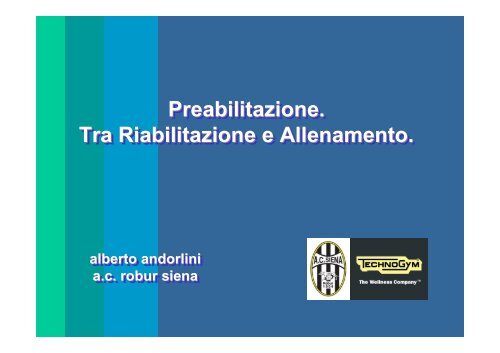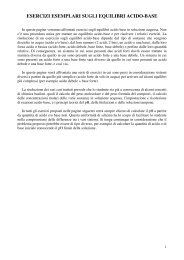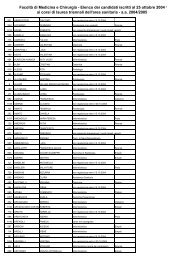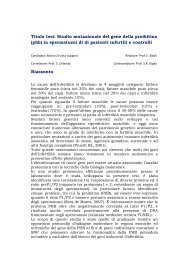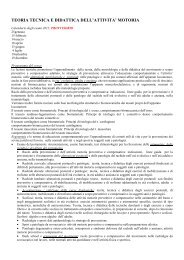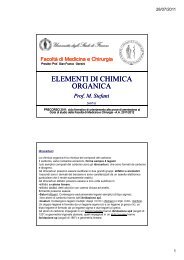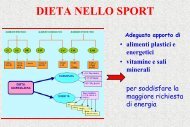Preabilitazione. Tra Riabilitazione e Allenamento. Preabilitazione ...
Preabilitazione. Tra Riabilitazione e Allenamento. Preabilitazione ...
Preabilitazione. Tra Riabilitazione e Allenamento. Preabilitazione ...
Create successful ePaper yourself
Turn your PDF publications into a flip-book with our unique Google optimized e-Paper software.
<strong>Preabilitazione</strong>.<br />
<strong>Preabilitazione</strong><br />
<strong>Preabilitazione</strong>. .<br />
<strong>Tra</strong> <strong>Riabilitazione</strong> e <strong>Allenamento</strong>.<br />
alberto andorlini<br />
a.c. robur siena
SCIENCE<br />
FICTION<br />
•“Following the functional path” in “The Gambetta Method”, by G.W.Gray, P.T. and<br />
V.Gambetta, MA in Physical Education - 1995<br />
• “The role of Proprioception in the Management and Rehabilitation of Athletic<br />
Injuries” by Scott M.Lephart, PhD,ATC; Danny M.Pincivero, Med; Jorge L.Giraldo,<br />
MD; Freddie H.Fu, MD; Pittsburgh Neuromuscular Research Laboratory - 1997<br />
•“Should Athletes <strong>Tra</strong>in Like Bodybuilders” by P.Check, Holistic Health Practitioner -<br />
2000 – 2004<br />
•“What is Functional Exercise” in “Movement that matters” by P.Check, Holistic<br />
Health Practitioner - 2000<br />
•“Functional <strong>Tra</strong>ining for Sports” by M.Boyle. Champaign IL: Human Kinetics - 2003<br />
•“The Role of Core in Athletic Function” by B.Kibler M.D., FACSM, A.Sciascia P.T.,<br />
Lexington Sports Medicine Center - 2006
FUNCTIONAL<br />
TRAINING<br />
Whether you are a marathon runner, a triathlete, or simply a homemaker<br />
who wants to carry their children without injury, functional training can<br />
help. Functional training has its origins in rehabilitation.<br />
Physical therapists developed exercises that MIMICKED what patients did<br />
at home or work in order to return to their lives or jobs after an injury or<br />
surgery.<br />
Thus if a patient's job required repeatedly heavy lifting, rehab would be<br />
targeted towards helping them achieve that. Functional training mostly<br />
involves activities targeted at the core muscles (abdominal and lower<br />
back)..<br />
http://www.sciencedaily.com/articles/f/functional_training.htm
PREHABILITATION<br />
These exercises will help reduce injury risks before an injury<br />
actually happens.<br />
The concept of ‘prehabilitation’ exercise training is now<br />
becoming well-known with trainers and therapists involved in<br />
sports performance preparation. Prehabilitation involves<br />
strength and conditioning exercises for specific muscles that<br />
help to reduce injury risks, before an injury actually occurs.<br />
It’s the classic ‘an ounce of prevention is better than a pound<br />
of cure‘ approach to physical training. Prehabilitation is sportspecific<br />
and targets common injuries and strength imbalances<br />
that occur in the particular sport.
PREHABILITATION<br />
What is Prehab?<br />
Prehab is is a personalized exercise program that continually evolves. It It provides sports specific focused<br />
exercises and activities for athlete's needs. The philosophy is is simple. Prevent injuries. The development<br />
and execution of of an an effective program can be be complex. The practice of of prehab and its itssuccess success relies greatly on on<br />
an an athlete's ability to to commit to to prevention. The development of of the program needs to to be be progressive and<br />
periodically re-evaluated to to change with the athlete's needs.<br />
Who Should Prehab?<br />
Athletes of of all all levels should include a prehab program in in their training. The more advanced the athlete, the<br />
greater the need for a prehab program. As an an athlete's body matures within a sport, their body adapts to to the<br />
physical demands of of training. Too often repetitive movements and the daily stresses of training<br />
cause negative effects within their bodies. This limited training technique may cause tightness of<br />
muscle groups, imbalances of strength, coordination or muscle stabilization. These imbalances<br />
occur naturally with activity and are reinforced with each workout. These imbalances are often the<br />
root of of many training injuries and may predispose athletes to to greater risk of of injury during training and<br />
competition.<br />
What Should be in a Prehab Program?<br />
A personalized Prehab program should address total body balance and consider sports specific needs. It It<br />
balances the range of of motion, strength, coordination and stabilization. Comparing left to to right, front to to back,<br />
upper to to lower body is is the basic premise. Exercises and sports specific skills and drills are focused on on an an<br />
athlete's weaknesses.<br />
The majority of prehab programs should focus on coordination and stabilization of the hips,<br />
stomach and back "core". Core instability is is common and is is often due to to the lack of of a proper training<br />
program. Many athletes and coaches use traditional protocols of of upper and lower body lifting or or basic sprinting<br />
and lifting routines, outside of of regular practice drills. This leaves the core without a direct focus or or training<br />
routine.
PREHABILITATION<br />
When Should an Athlete Prehab?<br />
As indicated, Prehab should be practiced before an injury places an athlete on the sideline and<br />
into a sports rehabilitation program. Unfortunately, it it often takes an an athlete and staff many injuries to to<br />
decide to to initiate a prehab program.<br />
Depending on on an an athlete's training cycle, prehab can be done within a practice session or as an<br />
independent workout. Three or or four exercises in in a warm up up or or cool down, a few exercises while resting or or<br />
waiting a turn in in practice, or or a detailed tedious workout focusing on on an an athlete's weaknesses. Full workouts can<br />
be be designed for off days or or active rest days. Mini prehab workouts are great for team travel and recovery days. In In<br />
any case, a prehab program should be bea a regular part of of an an athlete's training routine.<br />
Who Designs a Prehab Program?<br />
Athletes should be be screened for imbalances. Objective measurements of of active range of of motion and strength,<br />
biomechanical observations, past medical history, present health status and input from support staff should all all<br />
be be considered when designing a program. This screening should be be performed by by a qualified professional. A<br />
licensed healthcare professional, such as an Athletic <strong>Tra</strong>iner, Athletic Therapist, Sports<br />
Therapist or Physical Therapist with additional sports training, can design a program.<br />
The ability to to challenge and motivate an an athlete is isthe the difference between success and failure with respect to to<br />
a tailored prehab program. Knowledge of of the chosen sport, the athlete's needs and open communication are the<br />
keys to tosuccess success with prehabilitation.
PREHABILITATION = BE A BETTER BIPED
iabilitazione<br />
preabilitazione<br />
all.tradizionale<br />
all.funzionale
all.funzionale<br />
all.funzionale<br />
all.tradizionale<br />
all.tradizionale<br />
preabilitazione<br />
preabilitazione<br />
riabilitazione<br />
riabilitazione<br />
S<br />
T<br />
A<br />
B<br />
IL<br />
IZ<br />
Z<br />
A<br />
ZI<br />
O<br />
N<br />
E<br />
S<br />
T<br />
A<br />
B<br />
IL<br />
IZ<br />
Z<br />
A<br />
ZI<br />
O<br />
N<br />
E<br />
A<br />
D<br />
A<br />
T<br />
T<br />
A<br />
BI<br />
LI<br />
T<br />
A’<br />
A<br />
D<br />
A<br />
T<br />
T<br />
A<br />
BI<br />
LI<br />
T<br />
A’<br />
A<br />
D<br />
A<br />
T<br />
T<br />
A<br />
M<br />
E<br />
N<br />
T<br />
O<br />
A<br />
D<br />
A<br />
T<br />
T<br />
A<br />
M<br />
E<br />
N<br />
T<br />
O<br />
A<br />
L<br />
LI<br />
N<br />
E<br />
A<br />
M<br />
E<br />
N<br />
T<br />
O<br />
A<br />
L<br />
LI<br />
N<br />
E<br />
A<br />
M<br />
E<br />
N<br />
T<br />
O
all.funzionale<br />
all.funzionale<br />
all.tradizionale<br />
all.tradizionale<br />
preabilitazione<br />
preabilitazione<br />
riabilitazione<br />
riabilitazione<br />
C<br />
O<br />
R<br />
A<br />
B<br />
IL<br />
IT<br />
I<br />
E<br />
S<br />
C<br />
O<br />
R<br />
A<br />
B<br />
IL<br />
IT<br />
I<br />
E<br />
S<br />
M<br />
O<br />
S<br />
T<br />
A<br />
BI<br />
LI<br />
T<br />
Y<br />
M<br />
O<br />
S<br />
T<br />
A<br />
BI<br />
LI<br />
T<br />
Y<br />
Q<br />
U<br />
A<br />
LI<br />
T<br />
A<br />
’<br />
FI<br />
SI<br />
C<br />
H<br />
E<br />
Q<br />
U<br />
A<br />
LI<br />
T<br />
A<br />
’<br />
FI<br />
SI<br />
C<br />
H<br />
E<br />
I<br />
M<br />
B<br />
A<br />
L<br />
A<br />
N<br />
C<br />
E<br />
S<br />
I<br />
M<br />
B<br />
A<br />
L<br />
A<br />
N<br />
C<br />
E<br />
S
iabilitazione<br />
1. Joint<br />
position<br />
sense &<br />
Kinesthesia<br />
2. Dynamic<br />
joint<br />
Stabilization<br />
3. Reactive<br />
Neuromuscu<br />
lar Control<br />
4. Functionally<br />
specific<br />
Activities<br />
preabilitazione<br />
1. Be Centered<br />
2. Overcome<br />
Gravity<br />
3. Be<br />
Grounded<br />
4. Be Balanced<br />
5. Be Focused<br />
6. Master Body<br />
Weight<br />
7. Fundamenta<br />
l movements<br />
all.tradizionale<br />
1. Continuità<br />
del carico<br />
2. Aumento<br />
graduale &<br />
progressivo<br />
del carico<br />
3. Alternanza<br />
ciclica delle<br />
esercitazioni<br />
4. Ricchezza<br />
dei mezzi di<br />
all.<br />
all.funzionale<br />
1. CORE<br />
strength<br />
(before<br />
extremity<br />
strength)<br />
2. Movement<br />
not muscle<br />
3. Body Weight<br />
(before<br />
external<br />
resistance)<br />
4. Balance<br />
5. Tridimension<br />
al /Multiplane
iabilitazione<br />
preabilitazione<br />
all.tradizionale<br />
all.funzionale
iabilitazione<br />
preabilitazione<br />
all.tradizionale<br />
all.funzionale
iabilitazione<br />
preabilitazione<br />
all.tradizionale<br />
all.funzionale
iabilitazione<br />
preabilitazione<br />
all.tradizionale<br />
all.funzionale
iabilitazione<br />
preabilitazione<br />
all.tradizionale<br />
all.funzionale
iabilitazione<br />
preabilitazione<br />
all.tradizionale<br />
all.funzionale
<strong>Allenamento</strong> integrato


